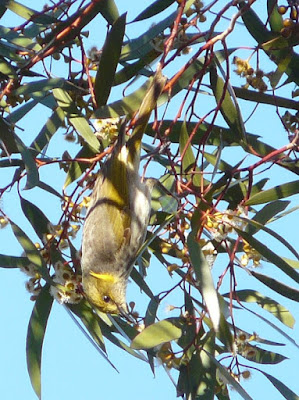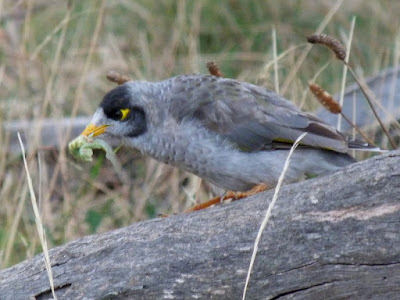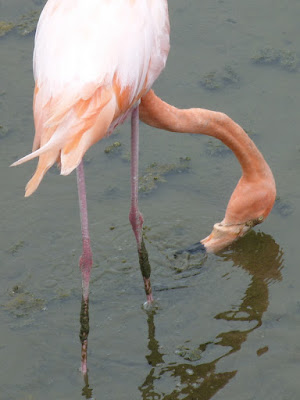In my last post I included a photo of a cuckoo-shrike overpowering, after quite a struggle, a big phasmid (or stick insect). In terms of relative sizes of hunter and hunted it's probably the biggest invertebrate prey I've seen consumed, but it made me think of the unimaginable myriads of invertebrates, especially insects, that are consumed by birds around the world every single day.
 |
| Here's the picture in case you missed it; a dark-phase White-bellied Cuckoo-shrike Coracina papuensisstruggling to overcome a huge, and presumably pregnant female, phasmid. Nowra, New South Wales. |
In this case the energy expended by the bird was considerable - I watched it struggling with the insect for at least 15 minutes - but the reward was very substantial and worth the effort. It would have found its lunch by searching the foliage of eucalypts for the camouflaged insects. Many birds hunt thus, gleaning leaves and branches for prey ranging in size from phasmids, cicadas and crickets to much smaller but more abundant fare.
 |
| Female Blue-crowned Trogon Trogon curucui, Muyuna Lodge on the Amazon River, northern Peru. She has also captured a very large stick insect. |
 |
| Yellow Wattlebird Anthochaera paradoxa with cicada, Bridport, Tasmania. Cicadas are smaller than phasmids, probably with more hard indigestible bits, but tend to be numerous. |
However most invertebrates gleaned from foliage are much smaller; as long as these snacks are sufficiently numerous and easy to find, the effort of snapping them up is also rewarded. I am constantly amazed at the number of caterpillars and other larvae that are lurking (and munching) on trees, shrubs and understorey plants, given the number that are eaten daily by birds and the number of chewed leaves that are still in evidence! Here are some efficient caterpillar-eaters, each of which must find many food items of this size every day - and of course far more if they're feeding hungry nestlings.
 |
| Male Crimson Chat Epthianura tricolor, Great Victoria Desert, Western Australia. |
 |
| Fire-eyed Diucon Xolmis pyrope, a tyrant flycatcher which specialises in living in the cold windy expanses of Patagonia. This one was in Torres del Paine NP in southern Chile |
 |
| Pallid Cuckoo Cacomantis pallidus, Great Victoria Desert; this caterpillar seems ridiculously small for the size of the bird, but again there was probably a good supply of them. |
 |
| Australasian Pipit Anthus novaeseelandiae near Canberra; I'm sure this beakful of caterpillars was going to feed demanding babies. |
Even smaller leaf-eating insects exist, and are also sought by many birds. Lerp is the term used for the larvae of many species of sap-sucking psyllids, which are true bugs (ie Hemipterans) that secrete surplus sugars to form waxy protective coatings. Many birds nip these off to access the insect inside. The most specific practitioners of this feeding method in Australia are the pardalotes, and on a still summer day the pattering of falling lerp covers can clearly be heard. Here are some honeyeaters which also feed on them, though each insect can only provide a tiny reward.
 |
| Fuscous Honeyeater Ptilotula fusca Jerrabomberra Wetlands, Canberra. Hanging upside down is an effective way to access the underside of leaves. |
 |
| Yellow-plumed Honeyeater Ptilotula ornata, Nundroo, far western South Australia. |
Finally before moving on from gleaning here is a bird whose prey's identity I'm not certain of. The Crested Shrike-tit Falcunculus frontatus is a powerful-billed gleaner now regarded as the sole member of its family. Normally it rips bark from tree trunks to extract small animals lurking beneath it, but this one was tearing apart a silken 'bag' in Callitris pine woodland.
 |
| I suspect the bag contained processional caterpillars (generally well-protected by stinging hairs), but I couldn't confirm that. |
Some birds specialise in catching insects in the air, while many others do it opportunistically. It requires great dexterity and skill.
 |
| Mixed flock of woodswallows (mostly White-browed and Masked) hunting flying insects in front of a coming storm, central Queensland. |
Dragonflies, though hard to catch, offer good rewards; they are an important part of the diet of Rainbow Bee-eaters Merops ornatus. This species and the next have long slim bills like forceps.
 |
| Rainbow Bee-eater with dragonfly, Namadgi National Park near Canberra. |
 |
| Great Jacamar Jacamerops aureus with unidentified flying prey, Manu Biosphere Reserve, Peruvian Amazonia. |
The Australian (and south-east Asian) fantails, Family Rhipiduridae, are mostly aerial specialists, but some species also chase prey along the ground with outstretched wings and tail, which both help with steering and flush insects from the ground.
 |
| Rufous Fantail Rhipidura rufifrons, Monga NP east of Canberra. |
Grasshoppers, being abundant and often conspicuously moving on the ground, are common victims of perch-and-pounce hunters. Here are some 'late' grasshoppers.
 |
| Crimson Chat male, Great Victoria Desert, Western Australia. |
 |
| Laughing Kookaburra Dacelo novaeguineae, Cape Hillsborough NP, Queensland. This is a big bird, often claimed as the world's biggest kingfisher; the meal is appropriately large too! |
 |
| Noisy Miner Manorina melanocephala, a common and pugnacious colonial honeyeater which is primarily an insectivore, Callum Brae NR, Canberra. |
 |
| Female White-browed Woodswallow Artamus superciliosus, Karumba, tropical Queensland. |
And I think this Yellow (or Green) Oriole Oriolus flavocinctus is about to eat a beetle (despite being mostly a fruit-eater). but it could equally probably have taken it off the ground or gleaned it from foliage.
 |
| Yellow Oriole (now often referred to as Green Oriole to avoid claimed confusion with an unrelated and utterly dissimilar bird from northern South America), Cairns, Queensland. |
Other birds extract prey, often wood-boring larvae, especially of moths or beetles, from living or dead wood. Those with finer bills extract their meals from crevices in bark.
 |
| White-browed Treecreeper Climacteris affinis near Canberra. Another old Gondwanan, but not at all related to the woodcreepers; a striking example of parallel evolution. |
 |
| Grey-crowned Babbler Pomatostomus temporalis, Longreach Waterhole, 700k south of Darwin. This one was assiduously probing holes in dead wood. |
Species with stronger bills simply smash their way into the wood to get their wriggling rewards. Woodpeckers, found in all vegetated continents except Australia, are famed for this. Small holes excavated by these little woodpeckers are obvious in these photos.
 |
| Cinnamon Woodpecker Celeus loricatus, Rio Silanche north-west of Quito, Ecuador. |
 |
| Yellow-fronted Woodpecker Melanerpes flavifrons near Sao Paulo, Brazil. |
Bigger woodpeckers make a much bigger mess of the tree however!
 |
| Magellanic Woodpecker Campephilus magellanicus excavation, Torres del Paine NP, Chilean Patagonia. This magnificent bird is up to 45cm long. |
They're not the only birds however which demolish wood in the search for big grubs.
 |
| Yellow-tailed Black-Cockatoo Calyptorhynchus funereus, tearing a wattle sapling apart to extract larvae, Murramarang NP, south coast NSW. |
Some birds dig into the ground to get their rewards.
 |
| Laughing Kookaburra, Rosedale, NSW south coast, whose beak shows how far it has been probing into the soil for food. |
Finally for today, while we tend to think of birds hunting in water as primarily interested in fish or frogs, many of them are interested in much smaller rewards and flocks of various waders extract many thousands of small animals from mud, sand and water daily. The principle is much the same whether they are probing into mud or water - they usually can't see what they're doing and rely totally on sensitive receptors in the tip of the bill and the inside of both upper and lower mandibles. These 'touch/taste' receptors (we have no equivalent) are packed in at densities of thousands per square millimetre. When a living organism is sensed (and they can distinguish between live food and inanimate objects) the bill snaps shut. While the moment of capture is beyond my means to photograph, and the prey is usually tiny, here are some practitioners going about their business.
 |
| Black-necked Stilt Himantopus mexicanus, Galápagos. |
 |
| Sanderling Calidris alba, also in the Galápagos; it has a much shorter stouter bill. |
 | |
| Immature White Ibis Threskiornis molucca above, and Yellow-billed Spoonbills Platalea flavipes, both at Jerrabomberra Wetlands, one of Canberra's premier birding spots. |
 |
| Ibis and spoonbills are closely related, but while ibis probe into the mud, spoonbills systematically sweep their bills from side to side in the water, snapping up tiny organisms as they contact them. |
Flamingos achieve the same result, but in a unique and seemingly improbable fashion, with their heads upside down!
Crabs are abundant invertebrates in most shore situations, and feature in many birds' diets.
 |
| Common Sandpiper Actitis hypoleucos with crab snack, Darwin. |
I recently observed a quite different bird enjoying a crustacean meal too, which took me quite by surprise. The light was wrong, but the subject makes it worth while.
 |
| Pied Currawong Strepera graculina, dismembering a freshly caught yabby (a common Australian freshwater crayfish), Cotter River Reserve, near Canberra. I can't readily find other accounts of this. |
Shellfish and other snails make a good meal, but require special techniques and strength to extract.
 |
| This bird was showing its skills in the Pantanal, south-western Brazil. |
So, there's an invertebrate for virtually anyone - at least for representatives of just about any bird family you can think of. Apparent declines in insect populations reported from many parts of the world are cause for concern for this reason, as well as many others. Meantime we can just wonder at the largely hidden vast diversity of small life on which millions of birds depend, and at the myriad of strategies developed to this end. It's still a wonderful world.
NEXT POSTING THURSDAY 13 AUGUST.
And remember that you can get a reminder when the next post appears by putting your email address in the Follow by Email box in the top right of this screen.
I'd love to receive your comments - it's easy and you don't need to sign in!
And remember that you can get a reminder when the next post appears by putting your email address in the Follow by Email box in the top right of this screen.
I'd love to receive your comments - it's easy and you don't need to sign in!








3 comments:
I am intrigued about the number of insects eaten worldwide and am giving a little thought (I only have little thoughts these days, but lots of time to fill with them) as to how to estimate this. My current approach is based on working out the daily energy requirement of a typical small bird (say a Yellow-faced Honeyeater) and the energy content of a typical insect (say a mosquito).
I shall see what Dr Google has to say about this but if you have pre-existing knowledge of either parameter please let me know!
That sounds like a very Martinesque project, and utterly admirable. David Paton from Adelaide Uni published a study on New Holland Honeyeaters and their energy requirements in the early 80s (?), I think in western Victorian heathlands. However the problem for you in selecting a honeyeater as a 'typical small bird' is that they get most of their energy intake from nectar; insects are only taken for protein and a relatively small part of their day is devoted to insect hunting. Maybe something like a Grey Fantail would better suit your purposes. However I still couldn't answer your questions, sorry. But I look forward to seeing what you come up with!
Amongst all the "right-wing charge a fortune" garbage that academics seem to use for their publications these days I have come across one paper that gets into some almost comprehensible data linking energy levels and body mass. What makes this amusing is that when I got my head around one of their formulae I realised it was the self same one that we were taught in uni ~50 years ago for working out the feeding regime for cattle!
As you would expect my calculations are not going to be at all precise. Possible I might get the number of zeroes right (or at least within 2 or 3).
Post a Comment